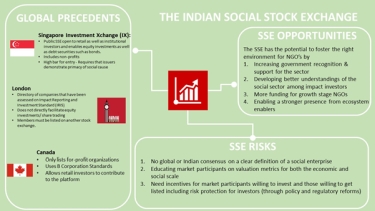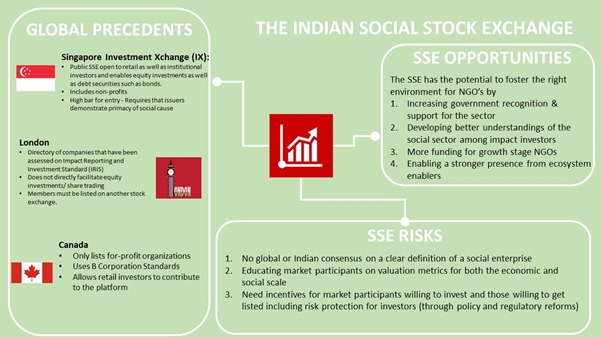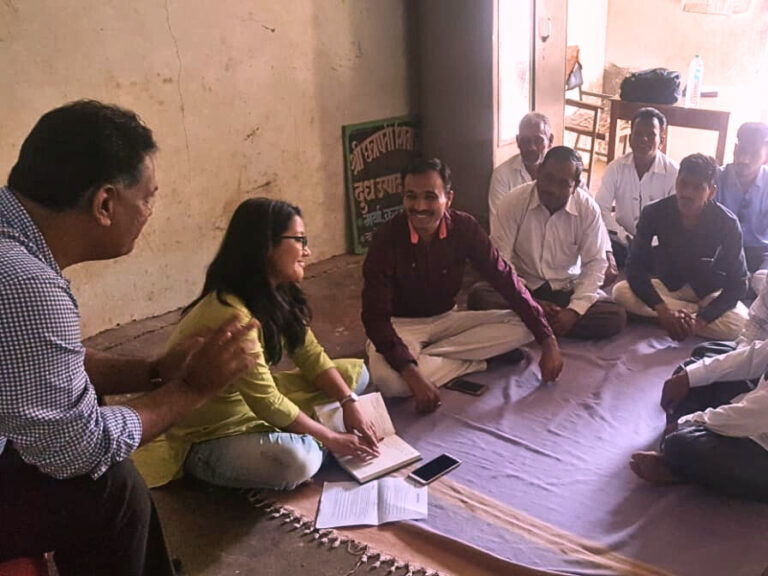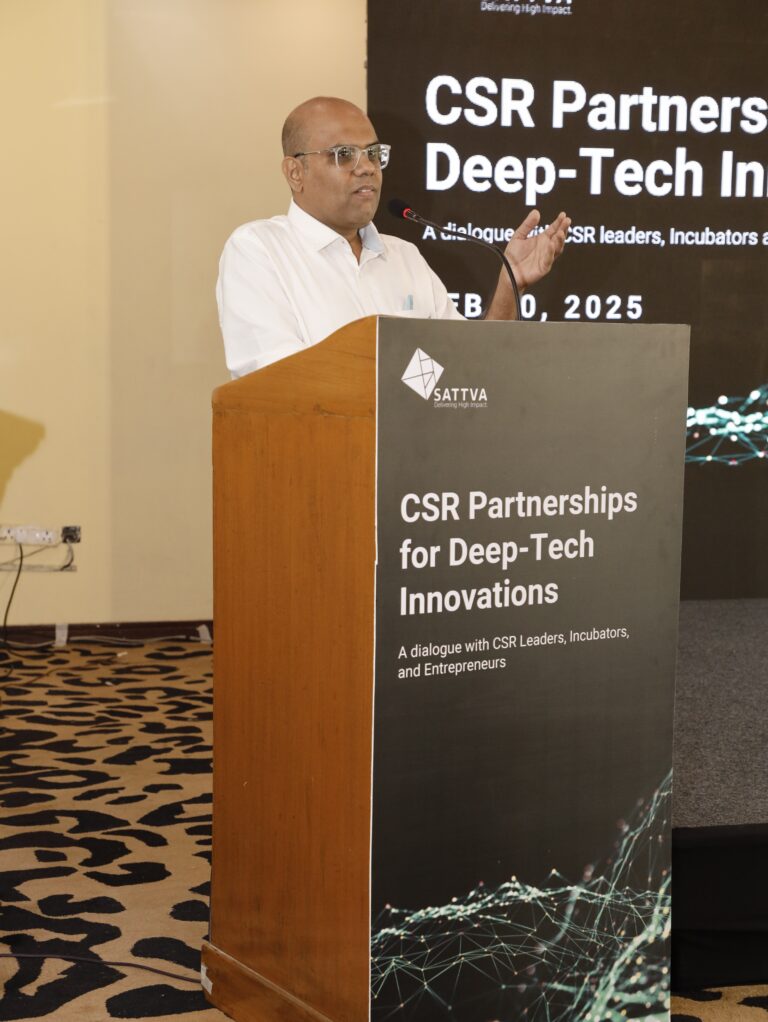Social Stock Exchange – a primer for Indian SPOs
– by Arpitha Rao
Background
In her budget speech in July 2019, the Indian Finance Minister Nirmala Sitharaman proposed a Social Stock Exchange (SSE) for social enterprises and voluntary organisations working for social welfare to help them raise capital through debt, equity and mutual funds. The proposed exchange will be under the regulation of Securities and Board Exchange of India (SEBI), will allow the listing of social enterprises and voluntary organisations and will function as an electronic fundraising platform. In September 2019, the SEBI constituted a working group to hone this further under chairman Ishaat Hussain, Director, SBI Foundation.
This news is indicative of a larger shift towards increased mobilisation of domestic capital for social purposes, and reducing India’s dependence on foreign aid. At Sattva, we studied the concept and implications of the SSE, especially in the context of flow of capital for Social Purpose Organisations (SPOs include for-profit social enterprises and non-profit organisations).
We are sharing our early learnings here as an SSE primer and we will follow up with additional insights as the topic evolves.
Current state of India’s social sector
Although India’s social economy is one of the most active in Asia, Indian SPOs continue to suffer from a low volume of deals and small viable pipelines for social enterprises, as well as consistent, long-term fundraising for non-profits. Indian SPOs face obstacles in raising capital to deliver social solutions due to a variety of factors including monitoring and evaluation challenges, lack of standardised methodologies for evaluating organisations, nascent impact investing environment, restricted / reduced funds for organisational growth and so on.
The SSE could improve this situation for Indian SPOs
Some potential scenarios where such an exchange can be leveraged to benefit SPOs include:
- – Functioning as a search directory listing credible and vetted Social Purpose Organisations
- – Enabling equity investments for Social Enterprises (institutional/ retail) across all stages of the capital value chain (SMEs to larger organisations)
- – Enabling issuance of financial instruments like bonds and notes for SPOs
- – Potential to create a common language around impact assessment and measurement and popularise this with donor ecosystem – both institutional and retail
- – Potential to increase unrestricted funds for Indian non-profit organisations.
Key considerations for the India SSE model:
As the idea is still nascent, with limited clarity on the overall structure of SSE, it is difficult to understand the impact of such a stock exchange on SPOs at this point. However, an SSE model with clarity in the following areas will greatly benefit the players in the ecosystem:
- – Clear, consistent definition of the terms ‘social enterprise’ and ‘voluntary organisation’: Given the ambiguity around the terms, a critical task for SSE would be to provide standard definitions to determine whether the model will predominantly provide space for non-profits or for-profit organisations. e.g. The inclusion of Section 8 companies in the SSE’s definition of ‘social enterprise’ could lead to well-funded entities also benefiting from this new initiative.
- – Measurement models that balance financial and social performance to assess SSE listed members: Ms Sitharaman has reiterated that the new SSE will use a rating mechanism which acknowledges the diversity of players in the social space. The rating tool will need to balance multiple indicators to measure and evaluate the performance of SPOs on this new platform. For instance, the appropriate financial performance measures (revenues for Social Enterprises, Operating budgets for NGOs) in the rating process would need to be balanced with social outcomes attributable to the organisations, to assess them on a level scale.
- – Clarity on how this initiative will interact with the Companies Act: Among other things, Section 135 of the Indian Companies Act mandates companies with revenue of more than INR 50 million to spend 2% of their profits on Corporate Social Responsibility (CSR) each year. It will be important to have clear guidelines on how CSR funds can be deployed via SSE.
- – Incentives for participants to drive engagement: Fostering widespread engagement among investors will be vital if NGOs are to raise adequate capital to fund their projects and expand their operations. Some incentives will be important for both market participants willing to invest and SPOs willing to get listed. For example, Investors may need some risk protection mechanisms (through policy and regulatory reforms)
What can SPOs do to prepare for SSE
At this early stage of its evolution, it will be important for SPOs to closely follow the developments related to SSE. Some research and thinking on the following areas would be beneficial:
- – Understand the global frameworks used to assess the impact of organisations; this may give insight into how SEBI could structure the valuation mechanism for the new platform. It is important to understand the mechanisms used by global SSEs such as the Impact Reporting and Investment Standards (IRIS), the Global Impact Investing Rating System (GIIRS) and The B Impact Assessment (BIA).
- – Explore the feasibility and design of a baseline measurement model to highlight social return on investments, based on a set of quantitative and qualitative indicators. Thinking along these lines for their own organisation’s work, irrespective of the final measurement framework used by the SSE, will be a helpful strategy exercise for SPOs.
Next steps
At Sattva, we will be closely following all news related to the SSE, given its enormous potential to impact the Indian social sector. Today, most of the focus in all conversations around SSE and similar exchanges in other countries seem more focussed towards social enterprises. We also see a need to engage with non-profits on this topic to understand their perspective and needs. We hope this article and our other forums of engagement will drive a rich, ongoing dialogue with all ecosystem actors on this critical topic.
Recently, Bangalore Mirror covered SSE in this article, with industry experts weighing in on the topic.
——————————————————————-
Arpitha Rao is part of our Transformation Advisory team and is based in our Bangalore office. Her current work focuses on large-scale transformations in public education. Before Sattva, Arpitha has worked with Teach for India, the India Literacy Project, and Greatest Common Factor. She followed up her Engineering degree with a Masters from TISS and an MBA from ISB.
Sattva has been working with various non-profits and social organisations as well as corporate clients to help them define their social impact goals. Our focus is to solve critical problems and find scalable solutions. We assist organisations in formulating their long-term social impact strategy by strategically aligning with business to provide meaningful solutions to social issues.
● We’d love to hear your thoughts and feedback on this topic. Do write to us: impact@sattva.co.in





